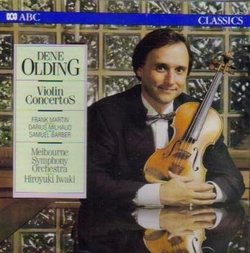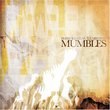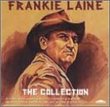| All Artists: Frank [1] Martin, Darius Milhaud, Samuel Barber, Hiroyuki Iwaki, Melbourne Symphony Orchestra Title: Martin, Milhaud, Barber: Violin Concertos Members Wishing: 0 Total Copies: 0 Label: ABC Classics Release Date: 1/23/1996 Album Type: Import Genre: Classical Styles: Forms & Genres, Concertos, Instruments, Strings Number of Discs: 1 SwapaCD Credits: 1 UPC: 730099700429 |
Search - Frank [1] Martin, Darius Milhaud, Samuel Barber :: Martin, Milhaud, Barber: Violin Concertos
 | Frank [1] Martin, Darius Milhaud, Samuel Barber Martin, Milhaud, Barber: Violin Concertos Genre: Classical |
Larger Image |
CD DetailsSimilar CDs |
CD ReviewsA trio of 20th century violin concertos Larry VanDeSande | Mason, Michigan United States | 03/01/2006 (3 out of 5 stars) "I bought this CD when a critic wrote wondrous things about the Milhaud Concerto No. 2 (not this version) and I found it mated here with the very familiar Barber and, to me, completely unfamiliar Martin concertos.
According to the liner notes, the concerto by French-born Frank Martin (1890-1974) capitalizes on the French and German influences the composer was under while being schooled in Paris in the 1920s. The concerto -- which is said to represent his mature style -- was premiered in 1952, making it peer to the concerto by American William Schuman. I would say this is not the only coincidental connection to the Schuman concerto, which is to me more confidently and artisticly constructed than the looser leaf Martin concerto. Even the score marking for the three movements -- allegro tranquillo, andante molto moderato, presto -- are similar to the Schuman concerto. In musical terms the concerto is angular, as is the Schuman, although it lacks the same thematic development qualities. It is composed on ideas from Shakespeare's "The Tempest", the notes tell us. The music is gently presented with French-sounding themes built from woodwinds and strings, often giving the affect of butterflies in a swirl. On first hearing it was easy to see what would sweep a critic away about the Milhaud concerto. The first movement (Dramatic recitaitve - anime) explodes with neoromantic fervor for both the orchestra and soloist. The second movement (marked "Light and sombre") seemed to me instead whimsical and dreamy. The finale is a return to postromanticism in brassy trauma before the solo entry in a lively interlude with woodwinds and virtuosic brass following. This ostinato theme continues until the whole thing concludes in a great single declaratory downbeat. The familiar Barber concerto was easier to differentiate with so very many wonderful recordings of it available in the CD marketplace. I thought the soloist and orchestra were uniformly straightforward and unimaginative in the opening movement. Both showed much greater passion in the middle "Andante" and both emphasized virtuosity in Barber's concluding "Presto in moto perpetuo". Dene Olding is billed as co-concertmaster of an Australian orchestra, while conductor Hiroyuki Iwaki is suited to his orchestra (Melbourne Symphony) in this recording. The 1991 sound is average for its period and lacks warmth and immediacy. I found this recording valuable for its program, less so for the execution by both soloist and orchestra. It's the kind of recording that leaves me wondering why it is still in print 15 years later when all kinds of wonderful productions go out of print in less than a year." |




